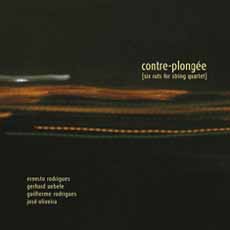
contre-plongée [six cuts for string quartet]
Ernesto Rodrigues | Gerhard Uebele | Guilherme Rodrigues | José Oliveira | cs011
There
aren't many string quartets (named as such) in the world of free improvised
music. Offhand I know of two - the Emergency String Quartet and the Quatuor
Accorde, and unfortunately the latter has (temporarily?) disbanded, after
one amazing release three years ago (Angel Gate, Emanem 4050). Ernesto
Rodrigues, Gerhard Uebele, Guilherme Rodrigues and José Oliveira
have deliberately chosen to avoid the quartet moniker (though "CS String
Quartet" might have been nice, as a friendly nod maybe to Dominic Duval's
CT String Quartet - itself now renamed), for the simple reason that Oliveira
plays guitar - a stringed instrument, though not normally featured in
a classical string quartet - but also the inside of a piano, which, as
any school kid will tell you is technically a percussion instrument. The
instruments of the conventional Western symphony orchestra have traditionally
been divided into four categories: wind, brass, percussion and strings,
but to quote a famous phrase of Steven Stapleton's, "categories strain,
crack and sometimes break, under their burden - step out of the space
provided." The music on this album is a fine example of musicians doing
just that: the sheer variety of playing techniques used here effectively
puts paid to any meaningful differentiation between instrumental families
as hitherto defined.
On the violin, viola and cello, the actual area in which the bow is normally
supposed to come into contact with the strings - between the bridge and
fingerboard - represents but a tiny fraction of the total area of the
instrument. Bowing slightly over the fingerboard is standard technique
(sul tasto), as is bowing near the bridge (sul ponticello), but these
musicians bow on and behind the bridge itself, behind the fingers, not
to mention on the pegs, neck, tailpiece, back and sides of their instruments.
Playing with the back of the bow (col legno) has been a special effect
known to classical music since Berlioz's "Symphonie Fantastique", but
here the frog of the bow and its metal binding are also used. And if that's
not enough, the strings themselves can be prepared with any number of
extraneous materials.
It's as if these venerable instruments have been discovered anew, approached
from an entirely different direction - hence the album title, borrowed
from the world of photography - "contre-plongée" translates as
"low-angle shot", and the associated expression "en contre-plongée"
means "from below".
What is equally clear from the music is that such a radical reappraisal
of the possibilities of traditional instruments is not possible without
an in-depth knowledge of their entire repertoire, including not only contemporary
classical key works but also the brief but eventful history of free improvised
music - including electronic improvised music. To quote another musician
who redefined - reinvented, almost - his instrument, Keith Rowe: "Today
there's an acoustic school influenced by electronics, [by] the way that
electronics can be translated to an instrumental context. How could a
trumpet player break through into something new? And suddenly, since Axel
Dörner, they've done it! There are four or five trumpet players around
who are really doing interesting stuff. Violin is yet to make a breakthrough.
But I'm sure it's going to come. Someone will crack it."
With contre-plongée, Messrs. Rodrigues, Rodrigues, Uebele and Oliveira
have not only cracked the violin, but exploded the whole concept of the
string quartet. Check it out.
Dan
Warburton
www.paristransatlantic.com